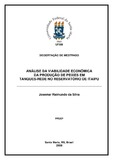| dc.creator | Silva, Josemar Raimundo da | |
| dc.date.accessioned | 2008-07-22 | |
| dc.date.available | 2008-07-22 | |
| dc.date.issued | 2008-03-25 | |
| dc.identifier.citation | SILVA, Josemar Raimundo da. ANÁLISE DA VIABILIDADE ECONÔMICA DA PRODUÇÃO DE PEIXES EM TANQUES-REDE NO RESERVATÓRIO DE ITAIPU. 2008. 158 f. Dissertação (Mestrado em Engenharia de Produção) - Universidade Federal de Santa Maria, Santa Maria, 2008. | por |
| dc.identifier.uri | http://repositorio.ufsm.br/handle/1/8061 | |
| dc.description.abstract | The present work had objective to analyze the economic-financial viability of aquaculture projects investment in cages for native species (jundiá, pacu and curimba). Aquaculture/fishculture inside of agribusiness has been presenting a growing interest and it should continue like this next decades, tends in view the stagnation in the fish offer originating from of the capture and of the growing increase in the demand for food with the increment of the world population. The increase of the consumption of fish and the progress of the aquaculture demand information for taking of decision about the economic viability of the enterprises in this area, mainly to native species. The investors, producers, technicians, fomentation organs and other institutions affect to the area, need safe information for taking decision about economic-financial viability of aquaculture/fishculture projects. In this sense this work verified that the production of native species in cages in the reservoir of Itaipu is unviable for the species jundiá (Rhamdia quelen) and curimba (Prochilodus lineatus), and viable for the Pacu (Piaractus mesopotamicus), which presented better adaptive to the production system and the climatic conditions. Analysis of Investment Return, Rate of Return, profitable Index, Internal Return Rate (IRR), Net Present Value (NPV) and Payback Period, all favorable ones were shown positively, with positive probability of occurrence ranging between 5% to 95% (90%) of the return of investment in a period among two (2) for three (3) years for the Monte Carlo simulation method. | eng |
| dc.format | application/pdf | por |
| dc.language | por | por |
| dc.publisher | Universidade Federal de Santa Maria | por |
| dc.rights | Acesso Aberto | por |
| dc.subject | Análise de investimento | por |
| dc.subject | Retorno e risco | por |
| dc.subject | Aqüicultura em tanques-rede | por |
| dc.subject | Espécies nativas | por |
| dc.subject | Reservatório de Itaipu (Santa Helena-PR) | por |
| dc.subject | Investment analysis | eng |
| dc.subject | Return and risk | eng |
| dc.subject | Aquaculture in cages | eng |
| dc.subject | Native species | eng |
| dc.subject | Reservoir of Itaipu (Santa Helena-PR) | eng |
| dc.title | Análise da viabilidade econômica da produção de peixes em tanques-rede no reservatório de ITAIPU | por |
| dc.type | Dissertação | por |
| dc.description.resumo | O presente trabalho teve como objetivo analisar a viabilidade econômico-financeira de investimento em projetos aqüícolas, especificamente em tanques-redes para espécies nativas (jundiá, pacu e curimba). A atividade aqüícola dentro do agronegócio tem apresentado um interesse crescente e assim deve continuar nas próximas décadas, tendo em vista a estagnação na oferta de pescado oriundo da captura e do crescente aumento na demanda por alimento com o incremento da população mundial. O crescimento do consumo de pescados e o avanço da aqüicultura demandam informações para tomada de decisão sobre a viabilidade econômica dos empreendimentos nesta área, principalmente no que se refere às espécies nativas. Os investidores, produtores, técnicos, órgãos de fomento e demais instituições afetas à área necessitam de informações seguras para tomada de decisão relativa a viabilidade econômica-financeira de projetos aqüícolas. Neste sentido este trabalhou verificou que a produção de espécies nativas em tanques-rede no reservatório de Itaipu se mostrou inviável para as espécies jundiá (Rhamdia quelen) e curimba (Prochilodus lineatus), e viável para a espécie Pacu (Piaractus mesopotamicus), a qual apresentou melhor adaptabilidade ao sistema de produção e as condições climáticas. Para a espécie pacu, a análise de Retorno do Investimento, da Taxa de Retorno, Índice de Lucratividade, Taxa Interna de Retorno (TIR), Valor Presente Líquido (VPL) e Período de Retorno do Investimento, se mostraram todos favoráveis positivamente, com probabilidade positiva de ocorrência variando entre 5% a 95% (90%) do retorno do investimento em um período entre dois (2) a três (3) anos pelo método de simulação de Monte Carlo. | por |
| dc.contributor.advisor1 | Rabenschlag, Denis Rasquin | |
| dc.contributor.advisor1Lattes | http://buscatextual.cnpq.br/buscatextual/visualizacv.do?id=K4266625J5 | por |
| dc.contributor.referee1 | Boscolo, Wilson Rogério | |
| dc.contributor.referee1Lattes | http://buscatextual.cnpq.br/buscatextual/visualizacv.do?id=K4767856E1 | por |
| dc.contributor.referee2 | Baldisserotto, Bernardo | |
| dc.contributor.referee2Lattes | http://buscatextual.cnpq.br/buscatextual/visualizacv.do?id=K4787286P0 | por |
| dc.creator.Lattes | http://buscatextual.cnpq.br/buscatextual/visualizacv.do?id=K4132284J5 | por |
| dc.publisher.country | BR | por |
| dc.publisher.department | Engenharia de Produção | por |
| dc.publisher.initials | UFSM | por |
| dc.publisher.program | Programa de Pós-Graduação em Engenharia de Produção | por |
| dc.subject.cnpq | CNPQ::ENGENHARIAS::ENGENHARIA DE PRODUCAO | por |


